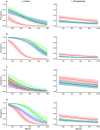High-elevational occurrence of two tick species, Ixodes ricinus and I. trianguliceps, at their northern distribution range
- PMID: 33736666
- PMCID: PMC7977262
- DOI: 10.1186/s13071-021-04604-w
High-elevational occurrence of two tick species, Ixodes ricinus and I. trianguliceps, at their northern distribution range
Abstract
Background: During the last decades a northward and upward range shift has been observed among many organisms across different taxa. In the northern hemisphere, ticks have been observed to have increased their latitudinal and altitudinal range limit. However, the elevational expansion at its northern distribution range remains largely unstudied. In this study we investigated the altitudinal distribution of the exophilic Ixodes ricinus and endophilic I. trianguliceps on two mountain slopes in Norway by assessing larval infestation rates on bank voles (Myodes glareolus).
Methods: During 2017 and 2018, 1325 bank voles were captured during the spring, summer and autumn at ten trapping stations ranging from 100 m to 1000 m.a.s.l. in two study areas in southern Norway. We used generalized logistic regression models to estimate the prevalence of infestation of both tick species along gradients of altitude, considering study area, collection year and season, temperature, humidity and altitude interactions as extrinsic variables, and host body mass and sex as intrinsic predictor variables.
Results: We found that both I. ricinus and I. trianguliceps infested bank voles at altitudes up to 1000 m.a.s.l., which is a substantial increase in altitude compared to previous findings for I. ricinus in this region. The infestation rates declined more rapidly with increasing altitude for I. ricinus compared to I. trianguliceps, indicating that the endophilic ecology of I. trianguliceps may provide shelter from limiting factors tied to altitude. Seasonal effects limited the occurrence of I. ricinus during autumn, but I. trianguliceps was found to infest rodents at all altitudes during all seasons of both years.
Conclusions: This study provides new insights into the altitudinal distribution of two tick species at their northern distribution range, one with the potential to transmit zoonotic pathogens to both humans and livestock. With warming temperatures predicted to increase, and especially so in the northern regions, the risk of tick-borne infections is likely to become a concern at increasingly higher altitudes in the future.
Keywords: Altitude; Bank vole; Distribution; Ixodes ricinus; Ixodes trianguliceps; Myodes glareolus; Range shift; Ticks.
Conflict of interest statement
All contributing authors declare that there are no conflicts of interest involved in this study.
Figures




Similar articles
-
The generalist tick Ixodes ricinus and the specialist tick Ixodes trianguliceps on shrews and rodents in a northern forest ecosystem--a role of body size even among small hosts.Parasit Vectors. 2015 Dec 16;8:639. doi: 10.1186/s13071-015-1258-7. Parasit Vectors. 2015. PMID: 26671686 Free PMC article.
-
Temporal dynamics of the tick Ixodes ricinus in northern Europe: epidemiological implications.Parasit Vectors. 2017 Mar 31;10(1):166. doi: 10.1186/s13071-017-2112-x. Parasit Vectors. 2017. PMID: 28359294 Free PMC article.
-
Sympatric Ixodes trianguliceps and Ixodes ricinus ticks feeding on field voles (Microtus agrestis): potential for increased risk of Anaplasma phagocytophilum in the United Kingdom?Vector Borne Zoonotic Dis. 2006 Winter;6(4):404-10. doi: 10.1089/vbz.2006.6.404. Vector Borne Zoonotic Dis. 2006. PMID: 17187576
-
Why is tick-borne encephalitis increasing? A review of the key factors causing the increasing incidence of human TBE in Sweden.Parasit Vectors. 2012 Aug 31;5:184. doi: 10.1186/1756-3305-5-184. Parasit Vectors. 2012. PMID: 22937961 Free PMC article. Review.
-
[Ixodes ricinus, transmitted diseases and reservoirs].Parassitologia. 2004 Jun;46(1-2):119-22. Parassitologia. 2004. PMID: 15305699 Review. Italian.
Cited by
-
Relating Wildlife Camera Trap Data to Tick Abundance: Testing the Relationship in Different Habitats.Animals (Basel). 2024 Sep 23;14(18):2749. doi: 10.3390/ani14182749. Animals (Basel). 2024. PMID: 39335338 Free PMC article.
-
Recommendations to Improve Tick-Borne Encephalitis Surveillance and Vaccine Uptake in Europe.Microorganisms. 2022 Jun 24;10(7):1283. doi: 10.3390/microorganisms10071283. Microorganisms. 2022. PMID: 35889002 Free PMC article. Review.
-
Canine Vector-Borne Diseases (CVBDs) in Liguria, North-West Italy: A Retrospective Study over an 11-Year Period (2013-2023).Animals (Basel). 2024 Dec 7;14(23):3539. doi: 10.3390/ani14233539. Animals (Basel). 2024. PMID: 39682504 Free PMC article.
-
Year-round tick exposure of dogs and cats in Germany and Austria: results from a tick collection study.Parasit Vectors. 2023 Feb 16;16(1):70. doi: 10.1186/s13071-023-05693-5. Parasit Vectors. 2023. PMID: 36797779 Free PMC article.
-
Host in reserve: The role of common shrews (Sorex araneus) as a supplementary source of tick hosts in small mammal communities influenced by rodent population cycles.Ecol Evol. 2022 Apr 11;12(4):e8776. doi: 10.1002/ece3.8776. eCollection 2022 Apr. Ecol Evol. 2022. PMID: 35432925 Free PMC article.
References
-
- Garcia-Vozmediano A, Krawczyk AI, Sprong H, Rossi L, Ramassa E, Tomassone L. Ticks climb the mountains: ixodid tick infestation and infection by tick-borne pathogens in the Western Alps. Ticks Tick-borne Dis. 2020;1:101489. - PubMed
-
- Tombre IM, Oudman T, Shimmings P, Griffin L, Prop J. Northward range expansion in spring-staging barnacle geese is a response to climate change and population growth, mediated by individual experience. Glob Change Biol. 2019;25(11):3680–3693. - PubMed
-
- Osland MJ, Feher LC. Winter climate change and the poleward range expansion of a tropical invasive tree (Brazilian pepper—Schinus terebinthifolius) Glob Change Biol. 2020;26(2):607–615. - PubMed
-
- Rubidge EM, Patton JL, Lim M, Burton AC, Brashares JS, Moritz C. Climate-induced range contraction drives genetic erosion in an alpine mammal. Nat Clim Change. 2012;2(4):285–288.
MeSH terms
LinkOut - more resources
Full Text Sources
Other Literature Sources
Medical

